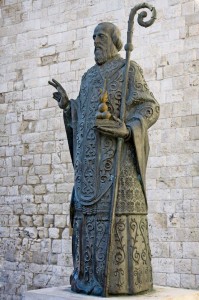If you happen to be in the neighborhood of Bari, Italy, on Dec. 6, be sure to swing by and pay tribute to the remains of Saint Nicholas — not to be confused with Santa Claus, who is most certainly alive and well and won’t be leaving home this year until Dec. 24.
Americans spending their first holiday season in Germany might be surprised to find that in this part of the world “Nikolaustag,” or Saint Nicholas Day, comes on the eve of Dec. 6. This is a night where German children put shoes or boots outside their door or windows with hopeful letters for Father Christmas.
Shoes, boots, stockings, slippers — how did this unusual tradition come to be? For that answer simply follow the Greek folklore all the way back to the fourth century. These were the days when Nicholas, an Orthodox Christian Bishop, wandered the land spreading miracles in his wake.

A statue of Saint Nicholas is pictured here in Bari, Italy.
Without a doubt, the most influential of these miracles comes from the story of the poor father. He had three daughters coming of age and no means to provide them with dowries. In that time, a girl without a dowry was a girl without a future, doomed for a life of prostitution.
Enter Nicholas the wandering bishop. This story has a number of variations, but one thing is constant: they all involve anonymous gifts of gold delivered through the window or door or even down the chimney at critical moments in this family’s life. According to folklore, the father finally caught their mysterious benefactor and tried to thank him. Like a true Saint, Nicholas insisted that it was not himself but God that the man should be thanking.
Despite the heart-warming good will that comes with stories of this world-renowned saint, it seems his remains have struggled to rest in peace.
For the first 600 plus years the bones of Nicholas were safely tucked away in Myra, an area of Asia Minor. But in the spring of 1087 a group of sailors — big fans of St. Nicholas — took advantage of political unrest happening in that part of the world and whisked half of Nicholas’ remains home to Italy.
Rumor has it someone once heard Nicholas mention that he’d like to be buried in Bari, Italy. Give a comment like that 600 plus years to ferment and what you end up with is a group of either rowdy or inspired Bari sailors (depending on who’s telling the tale) who take the initiative and kidnap just over half of their patron saint’s bones.
The other half were eventually swept up and collected by yet another group of sailors — this time from Venice — who entombed the rest of him in a church built on the Lido.
Scientists have since confirmed that, yes, the bones in these two locations are all related to the same individual. He was roughly 5 feet tall and had a broken nose. There was no information found that might shed light on his waist measurement or complexion.
On Dec. 28, 2009, the Turkish government officially requested the return of St. Nicholas’s skeletal remains from the Italian government. They talked to somebody who talked to somebody who said their uncle once heard that St. Nicholas himself desired to be buried in his hometown and they want him back, that is, if the bones in question really belong to St. Nick at all. There’s quite a bit of evidence that suggests he faked his death and permanently resides somewhere up north with a small army of elves.
But let’s just keep that little piece of information to ourselves, shall we?


